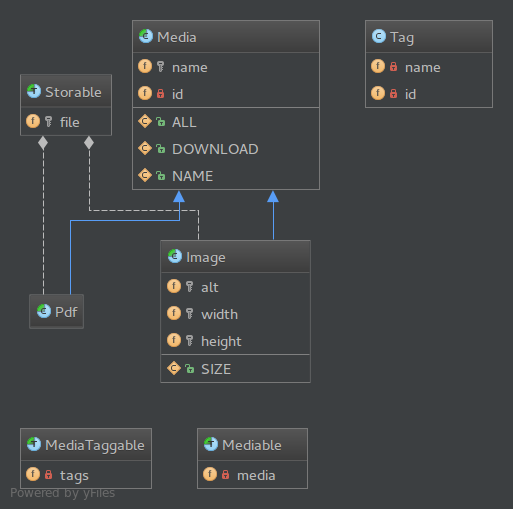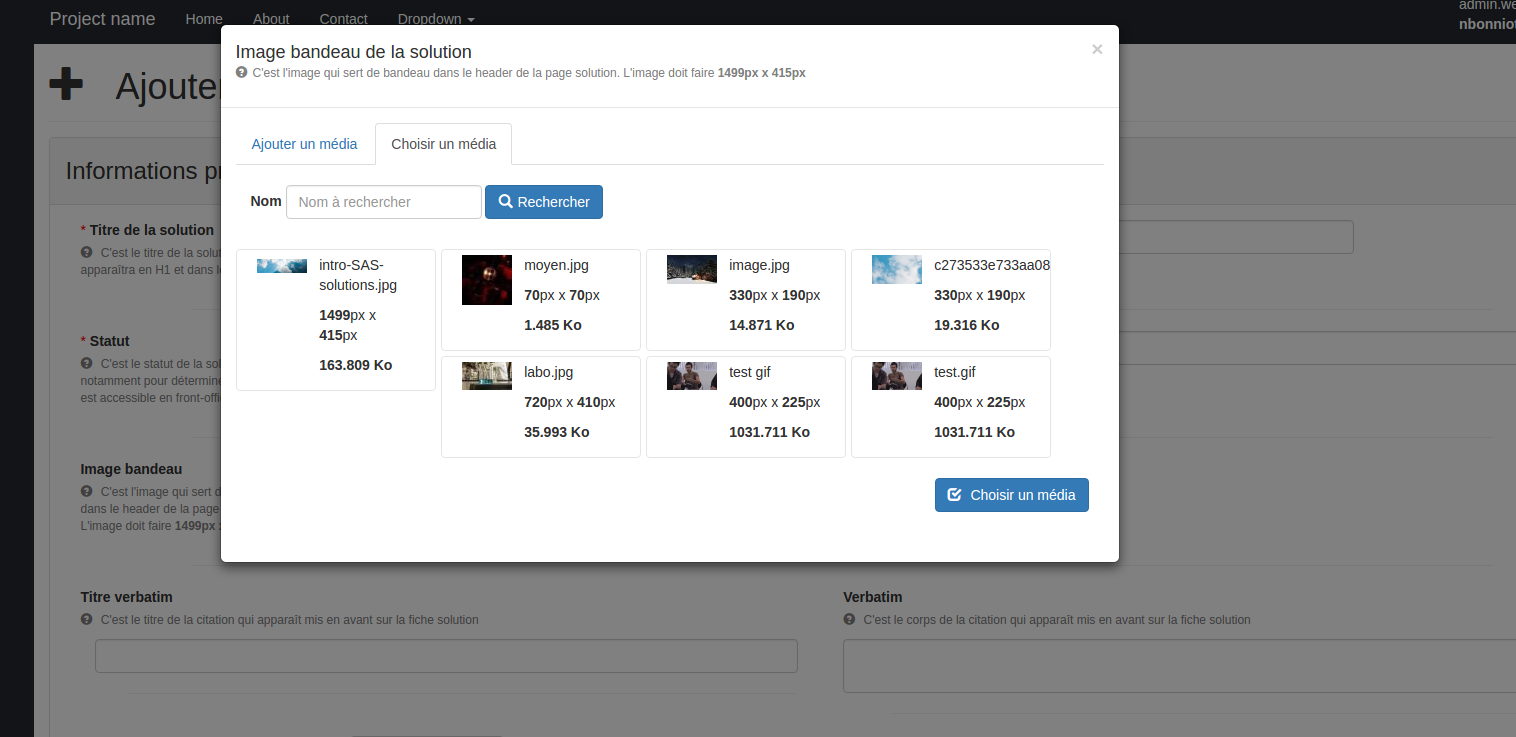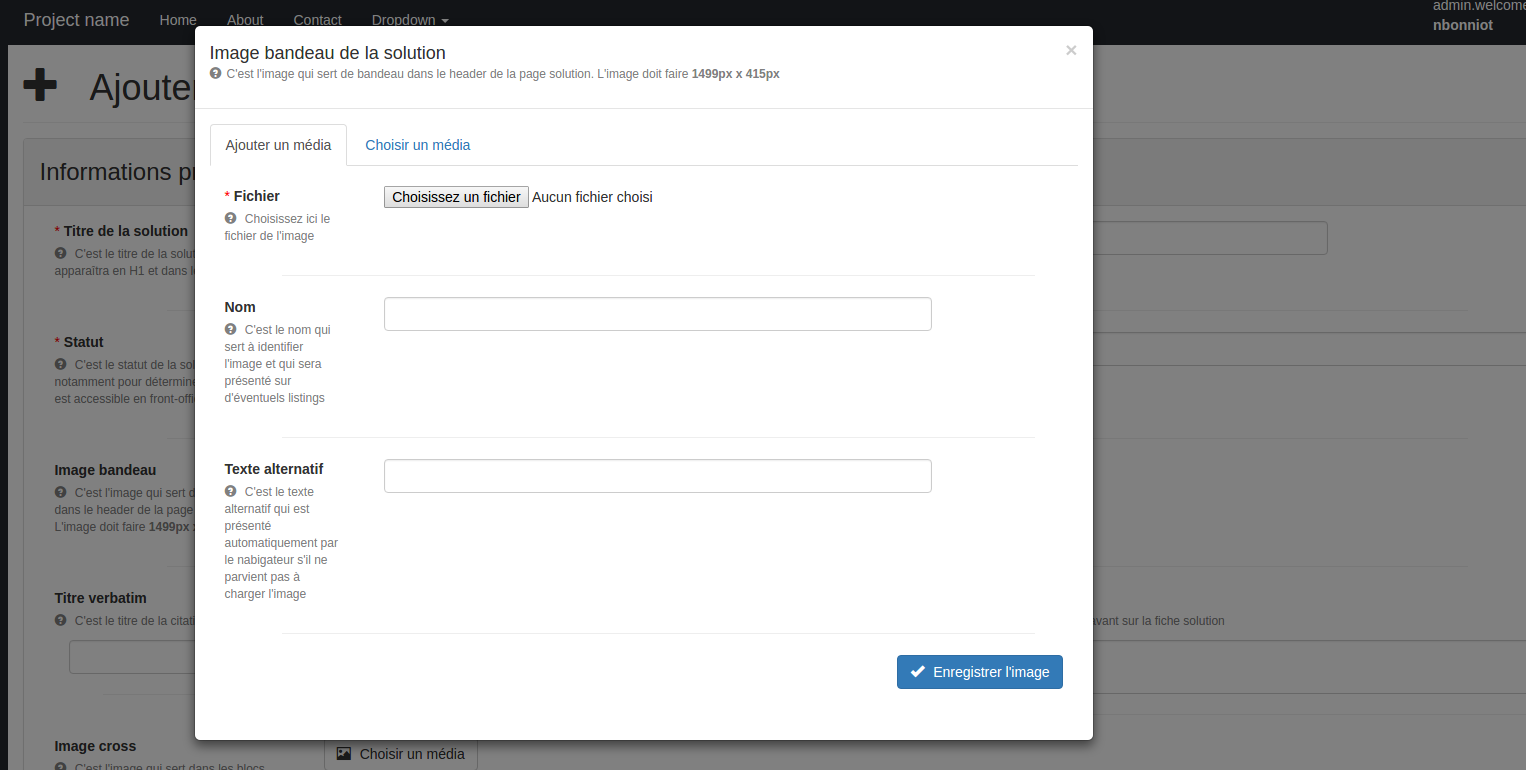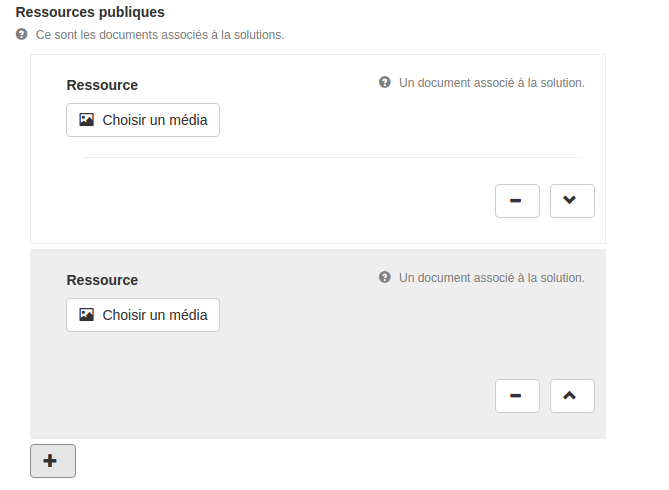This bundle brings to you a comprehensive and code-close way of handling media for Symfony 3.
Features:
- Defines media types in config.yml
- Provides events to hook on all process (CRUD)
- Provide form types to interact easily in you admin (pick an existing media/creates a new one)
- Provides Twig extension to ease media display and manipulation in Twig files (get URLs, thumbnails...)
- Provides validators to restrain media to boundaries (size, resolution for images, extensions...), (*1)
Installation and pre-requisites
Imagick is used to generate thumbnails and images sizes sets.
On the GUI side, the bundle use Bootstrap 4 and jQuery. Be sure those 2 dependencies are fullfilled, especially on admin screens (media selection/creation), (*2)
For installing, use simply :
composer require lch/media-bundle, (*3)
Configuration and usage
- General explanations
- Media types declaration
- Twig extensions and tools
- Events
- Form types
- Validators
- Storage strategy
- Image sizes
-
Practical use cases
- Download control
General explanations
Out of the box, MediaBundle defines 2 types : image and pdf. You can use those types as base for you custom ones., (*4)
Below is shown types and available fields :, (*5)
 , (*6)
, (*6)
You need to define your media types in config.yml. You can define as many types as you need, using the following syntax :, (*7)
lch_media:
types:
image:
name: 'your_project.image.name' # the translated name for front presentation
entity: 'YourBundle\Entity\Media\Image' # the entity to be used
form: 'YourBundle\Form\Media\ImageType' # the form to be used when adding media
add_view: 'YourBundle/Media/Image/fragments:add.html.twig' # the add form view to be used when adding media
thumbnail_view: 'YourBundle/Media/Resource/fragments:thumbnail.html.twig' # the view used for displaying thumbnail
list_item_view: 'YourBundle/Media/Resource/fragments:list.item.html.twig' # the view used for displaying list item in selection lists
extensions: ['jpg', 'jpeg', 'png', 'gif'] # allowed extensions
max_items_per_page: 20 # not required, 20 per default
thumbnail_sizes:
news:
width: 396
height: 227
Let's review an example for each given key :, (*8)
Entity
Minimal class for above declared image could be :, (*9)
<?php
namespace YourBundle\Bundle\Entity\Media;
use Doctrine\ORM\Mapping as ORM;
use Knp\DoctrineBehaviors\Model\Blameable\Blameable;
use Knp\DoctrineBehaviors\Model\Timestampable\Timestampable;
use Lch\MediaBundle\Entity\Image as BaseImage;
/**
* Image
*
* @ORM\Table(name="image")
* @ORM\Entity(repositoryClass="YourBundle\Repository\Media\ImageRepository")
*/
class Image extends BaseImage
{
use Blameable,
Timestampable;
}
It extends Lch\MediaBundle\Entity\Image. If you want to start from scratch, you have to extends from Media and use Storable behavior in order to trigger all stuff link to file storage in the bundle., (*10)
Minimal form class could be :, (*11)
<?php
namespace YourBundle\Form\Media;
use Symfony\Component\Form\FormBuilderInterface;
use Symfony\Component\OptionsResolver\OptionsResolver;
use Lch\MediaBundle\Form\ImageType as BaseImageType;
// Extends BaseImageType here for overriding constants
class ImageType extends BaseImageType
{
/**
* BaseImageType defines a NAME constant for generic image type. You override it here with your type name
*/
const NAME = 'your_image_type';
/**
* Same for root translation path to be used in your particular type case
*/
const ROOT_TRANSLATION_PATH = 'your.back.media.form.image';
/**
* @inheritdoc
*/
public function buildForm(FormBuilderInterface $builder, array $options)
{
// Explicit parent call is required for constant overriding
parent::buildForm($builder, $options);
}
/**
* @inheritdoc
*/
public function configureOptions(OptionsResolver $resolver)
{
$resolver->setDefaults([
'data_class' => 'YourBundle\Entity\Media\Image'
]);
}
/**
* @inheritdoc
*/
public function getParent()
{
return BaseImageType::class;
}
}
Add view
You can find below the add view for generic Image defined by the bundle :, (*12)
{% form_theme mediaForm 'bootstrap_3_layout.html.twig' %}
{{ form_errors(mediaForm) }}
{{ form_start(mediaForm) }}
{{ form_row(mediaForm.file) }}
{{ form_row(mediaForm.name) }}
{{ form_row(mediaForm.alt) }}
<div class="text-right col-xs-12">
{{ form_row(mediaForm.submit) }}
</div>
{{ form_rest(mediaForm) }}
{{ form_end(mediaForm) }}
If you define your own, you have to use mediaForm as the form variable., (*13)
Thumbnail view
You can find below the thumbnail view for generic Image defined by the bundle :, (*14)
<img src="{{ thumbnailEvent.thumbnailPath }}" alt="{{ thumbnailEvent.media.alt }}" />
Note : as indicated below, most of logic is event related. Thumbnail generation is one those things, so access to thumbnail data goes through event object, (*15)
List item view
You can find below the list item view for generic Image defined by the bundle. You will find further explanations on twig methods below, (*16)
{% set attrs = "" %}
{% for key, attr in attributes %}
{% set attrs = attrs ~ " " ~ key ~ '=' ~ attr %}
{% endfor %}
{% set size = listItemEvent.media.file.getSize()/1000 %}
Note : as indicated below, most of logic is event related. Thumbnail generation is one those things, so access to thumbnail data goes through event object, (*20)
Extensions
Here you define extensions allowed for this media type, as an array., (*21)
Thumbnail sizes
More informations in dedicated section, (*22)
-
{{ get_list_item(media, attributes) }} : display a list item
-
{{ get_thumbnail(media, attributes) }} : display the media thumbnail (called in getListItem)
-
{{ get_thumbnail_url(media, attributes) }} : return the thumbnail URL only (where get_thumbnail will return an HTML ![]() tag)
tag)
-
{{ get_url(media, attributes) }} : returns the URL for the given media. direct media URL by default, but you can easily hook on DOWNLOAD event to return something more complicated (such as downloader for private resources)
You can find below a graphical render for several methods listed above :, (*23)
 , (*24)
, (*24)
Events
You can find below the complete event list thrown by the bundle (listed in Lch\Media\LchMediaEvents) :
- LchMediaEvents::DOWNLOAD : fired by MediaController before preparing response to deliver file, but after security check
- LchMediaEvents::LIST_ITEM : fired by MediaManager when Twig method {{ getListItem(media, attributes) }} is called
- LchMediaEvents::PRE_DELETE : fired by MediaController before media deletion
- LchMediaEvents::PRE_PERSIST : fired by MediaController before media persistance
- LchMediaEvents::PRE_SEARCH : fired by MediaManager on every list calls
- LchMediaEvents::POST_DELETE : fired by MediaController after media deletion
- LchMediaEvents::POST_PERSIST : fired by MediaController after media persists
- LchMediaEvents::POST_SEARCH : fired by MediaManager on every list calls
- LchMediaEvents::REVERSE_TRANSFORM : used by AddOrChooseMediaType form type
- LchMediaEvents::SEARCH_FORM : fired by MediaManager on list call to get specific input type in order to contextualize search form to media type
- LchMediaEvents::PRE_STORAGE : fired by MediaController before media file storage
- LchMediaEvents::POST_STORAGE : fired by MediaController after media file storage
- LchMediaEvents::THUMBNAIL : fired by MediaManager when Twig method {{ getThumbnail(media, attributes) }} is called
- LchMediaEvents::TRANSFORM : used by AddOrChooseMediaType form type
- LchMediaEvents::URL : fired by MediaManager when Twig method {{ getUrl(media, attributes) }} is called, (*25)
The bundle provides 2 form types for easing media selection/creation. First of all, be assured to add the correct form theme file in your admin twig files, which is LchMediaBundle:form:fields.html.twig, (*26)
Here is a classical use :, (*27)
$builder
->add('myImage', AddOrChooseMediaType::class, [
'entity_reference' => Image::class,
'label' => static::ROOT_TRANSLATION_PATH . ".my_image.label",
'modal_title' => static::ROOT_TRANSLATION_PATH . '.my_image.modal.title',
'image_width' => 1499,
'image_height' => 415,
'required' => false,
'attr' => [
'helper' => static::ROOT_TRANSLATION_PATH . '.my_image.helper'
]
])
;
Although it's quite clear, note that entity_reference is the media class you want to link here. Regarding validation, you can pass
- image_width and image_height for exact image size required
- min_image_width, max_image_width, min_image_height, max_image_height for image size boundaries
- min_media_weight and max_media_weight for media size, (*28)
Have a look to validators section in order to have more details., (*29)
You must then register a Twig namespace, and add the bundle field.html.twig as a form_theme :, (*30)
twig:
#...
paths:
#...
'%kernel.project_dir%/vendor/lch/media-bundle/Resources/views': LchMediaBundle
form_themes:
#...
- 'bootstrap_4_layout.html.twig'
- '@LchMediaBundle\form\fields.html.twig'
Then, assuming you added form_theme as stated above, the twig parent form type become :, (*31)
{% block css %}
{{ parent() }}
{# Media #}
<link rel="stylesheet" href="{{ asset('bundles/lchmedia/css/media.css') }}" type="text/css" />
{% endblock css %}
{% block your_content %}
{ form_start(form) }}
{{ form_errors(form) }}
{# ... #}
{{ form_row(form.myImage) }}
{# ... #}
{% endblock your_content %}
{% block scripts %}
{{ parent() }}
{# Routing : needed for interaction in the media popin #}
<script src="{{ path('fos_js_routing_js', {'callback': 'fos.Router.setData'}) }}"></script>
{# Medias #}
<script src="{{ asset('bundles/lchmedia/js/isotope.js') }}"></script>
<script src="{{ asset('bundles/lchmedia/js/jquery.media.js') }}"></script>
<script src="{{ asset('bundles/lchmedia/js/media-search.js') }}"></script>
{% endblock scripts %}
You have to add those 3 javascript files in order to make things work.
- The list use isotope to make elegant item presentation
- All logic (list/creation) is handled via jQuery plugin jquery.media.js
- media-search.js contains JS logic around search (externalized to be used on a specific library page), (*32)
Result (after custom styling):
Button chooser in parent form :
 , (*33)
, (*33)
After click on button, media popin appears with media chooser among available (limited to entity_reference you provided)
 , (*34)
, (*34)
You can also add a media from here (limited to entity_reference you provided, and using form and add_view you provided for media type in config.yml)
 , (*35)
, (*35)
Note : as you can see in LchMediaBundle:form:fields.html.twig, we postfixed all relevant HTML input ids with a random unique number, therefore safely allowing multiple media type usage in same form., (*36)
This type is useful to select a collection of media. It only makes the AddOrChooseMediaType repeatable, (*37)
$builder
->add('resources', AddOrChooseMultipleMediasType::class, [
'label' => static::ROOT_TRANSLATION_PATH . '.public_documents.label',
'allow_add' => true,
'allow_delete' => true,
'prototype' => true,
'entry_type' => AddOrChooseMediaType::class,
'entry_options' => [
'entity_reference' => Resource::class,
'label' => "your_project.test.label",
'modal_title' => static::ROOT_TRANSLATION_PATH . '.public_documents.document.modal.title',
'attr' => [
'helper' => static::ROOT_TRANSLATION_PATH . '.public_documents.document.helper'
]
],
'attr' => array(
'class' => 'public-documents',
'helper' => static::ROOT_TRANSLATION_PATH . '.public_documents.helper',
),
])
;
We suggest using the excellent Symfony collection plugin to handle collection easily. We still have to elaborate JS part a lot, so for now you have to repeat the random number change when dynamically adding media button., (*38)
Example below linked to above AddOrChooseMultipleMediasType (with symfony collection), (*39)
$('.public-documents').collection({
up: '<a href="#" class="btn btn-default"><i class="glyphicon glyphicon-chevron-up"></i></a>',
down: '<a href="#" class="btn btn-default"><i class="glyphicon glyphicon-chevron-down"></i></a>',
add: '<a href="#" class="btn btn-default"><i class="glyphicon glyphicon-plus"></i></a>',
remove: '<a href="#" class="btn btn-default"><i class="glyphicon glyphicon-minus"></i></a>',
duplicate: '<a href="#" class="btn btn-default"><i class="glyphicon glyphicon-duplicate"></i></a>',
// Change the random number to ensure uniqueness
after_add: function(collection, element) {
var $mediaSelector = element.find('.media-selector-container');
// Renew random ID on just added media selector
$mediaSelector.lchMedia('renewRandomId');
return true;
}
})
);
Result (after custom styling):
Repeatable media selector :
 , (*40)
, (*40)
Validators
You will find in Lch\MediaBundle\Validator several built-in validators :
- HasAllowedFileExtension : for extension check based on configuration
- Weight : min/max, exact weight
- Image
- ImageSize : for image size check (width, height, min width, min height), (*41)
All validators work both on class and property level. So you need to define them on your media classes once for all :, (*42)
<?php
namespace YourBundle\Entity\Media;
use Doctrine\ORM\Mapping as ORM;
use Knp\DoctrineBehaviors\Model\Blameable\Blameable;
use Knp\DoctrineBehaviors\Model\Timestampable\Timestampable;
use Lch\MediaBundle\Behavior\MediaTaggable;
use Lch\MediaBundle\Behavior\Storable;
use Lch\MediaBundle\Entity\Media;
use Lch\MediaBundle\Validator\Constraints as MediaAsset;
/**
* Resource
*
* @ORM\Table(name="resource")
* @ORM\Entity(repositoryClass="YourBundle\Repository\Media\ResourceRepository")
* @MediaAsset\HasAllowedFileExtension()
* @MediaAsset\MediaWeight()
*/
class Resource extends Media
{
// Remember to use the Storable to ensure physical file is correctly stored
use Storable,
;
}
Storage strategy
TODO, (*43)
Image sizes
Using Imagick, the bundle does 2 things :, (*44)
- Generating thumbnails for all images
- Generating viewable thumbnails for PDF files (thumbnails for list item and previewer)
Using the correct key (thumbnail_sizes) in media type declaration in config.yml, you can produce as many thumbnails you need., (*45)
Note : so far, we use the image longer dimension and adapt the other one to keep homothetic transforms. Therefore, resulting images might not be in the exact good resolution. To be completed..., (*46)
Practical use cases
Download control
- Declare media (see above)
- Register a Listener/Subscriber to LchMediaEvents::STORAGE to change storage for your media (example : to add a "/private/" subfolder)
- Add matching route, to force Symfony to handle request :
yml
ipc_media_download:
path: /uploads/resources/{id}
defaults: { _controller: LchMediaBundle:Media:download, class: '%lch_media.types.resource.entity%' }
methods: [ GET ]
- Add a Voter to restrain service
-
Option : Register a Listener/Subscriber to LchMediaEvents::DOWNLOAD to control what to serve (add watermark...), (*47)
TODO : to be completed with detailled event usage examples, (*48)
 Wallogit.com
Wallogit.com
 , (*6)
, (*6) , (*24)
, (*24) , (*33)
, (*33) , (*34)
, (*34) , (*35)
, (*35) , (*40)
, (*40)